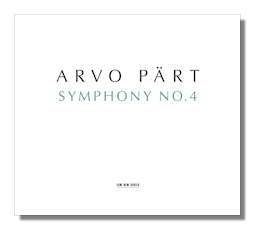
The Internet's Premier Classical Music Source
Related Links
- Pärt Reviews
- Latest Reviews
- More Reviews
-
By Composer
-
Collections
DVD & Blu-ray
Books
Concert Reviews
Articles/Interviews
Software
Audio
Search Amazon
Recommended Links
Site News
 CD Review
CD Review
Arvo Pärt

- Symphony #4 "Los Angeles" (35:09)
- Fragments from Kanon pokajanen (14:50)
Los Angeles Philharmonic Orchestra/Esa-Pekka Salonen
Estonian Philharmonic Chamber Choir/Tonu Kaljuste
ECM New Series 2160
What we have here is a concert recording at its première in January 2009 of a three-movement symphony for strings and percussion and music for a cappella choir that comes from a larger piece. Each is based on a canon and Pärt says that "the two works form a stylistic unity and they belong together in a way." Reportedly, the text (not included here) of the "Canon of the Guardian Angel" was the point of departure for the symphony in that it has the "character of Church Slavonic poetry…with its special Slavonic diction." Pärt says that the results surprised even him.
It has been nearly four decades since Pärt wrote his third symphony, and this one could not be more different. It does show evidence of the studies of polyphony he was making around the time of that previous symphony, as the canonic form he uses here features simultaneous lines of sound. The symphony is dedicated to Mikhail Khodorkovsky, and was commissioned by Esa-Pekka Salonen, the Los Angeles Philharmonic Association, the Canberra International Music festival/Ars Musica Australis, and the Sydney Conservatorium of Music.
The symphony's first movement, con sublimita, has more than one change of pace. It begins with high shimmering strings punctuated with the pluck of a harp and a single stroke on a triangle. Below the high shimmer a theme slowly descends the scale until it is taken by the basses. Then a loud drum and bell punctuates a slow march. When a softer mood follows, strings are accompanied by a two note beat on the timpani, the second note lower; later the basses do what the timpani was doing, in accompanying the higher strings.
The second movement, marked Affannoso, meaning breathless or anxious, is faster and has some dissonance. Plucked basses, a variety of percussion instruments, and a few effects difficult to identify are heard. Late in the movement there is loud drumming and massed strings playing legato. There are some long-held notes under which melody is heard, as was the case in the opening movement.
The final movement, Deciso, opens pleasantly with some modal harmony and a solo violin solo playing a sweet melody which other strings take over and develop. Broad midrange playing follows with a plucked accompaniment but this is succeeded by another march with drums and bells at a steady tempo. Towards the end, high strings become shrill and intense but there is a soothing harp at the end.
I have been attempting to give an idea of what this music sounds like, but what I have not said is that there is much beautiful music here. The unaccompanied chorus in the work following on this release is also very beautiful. It is mostly slow and solemn, soft and peaceful, and with polyphonic effects. Although no text is supplied, none is missed, as far as this listener is concerned. I believe I did catch an "amen" but the music works, as in the symphony, as pure sound.
Highly recommended.
Copyright © 2010, R. James Tobin





















